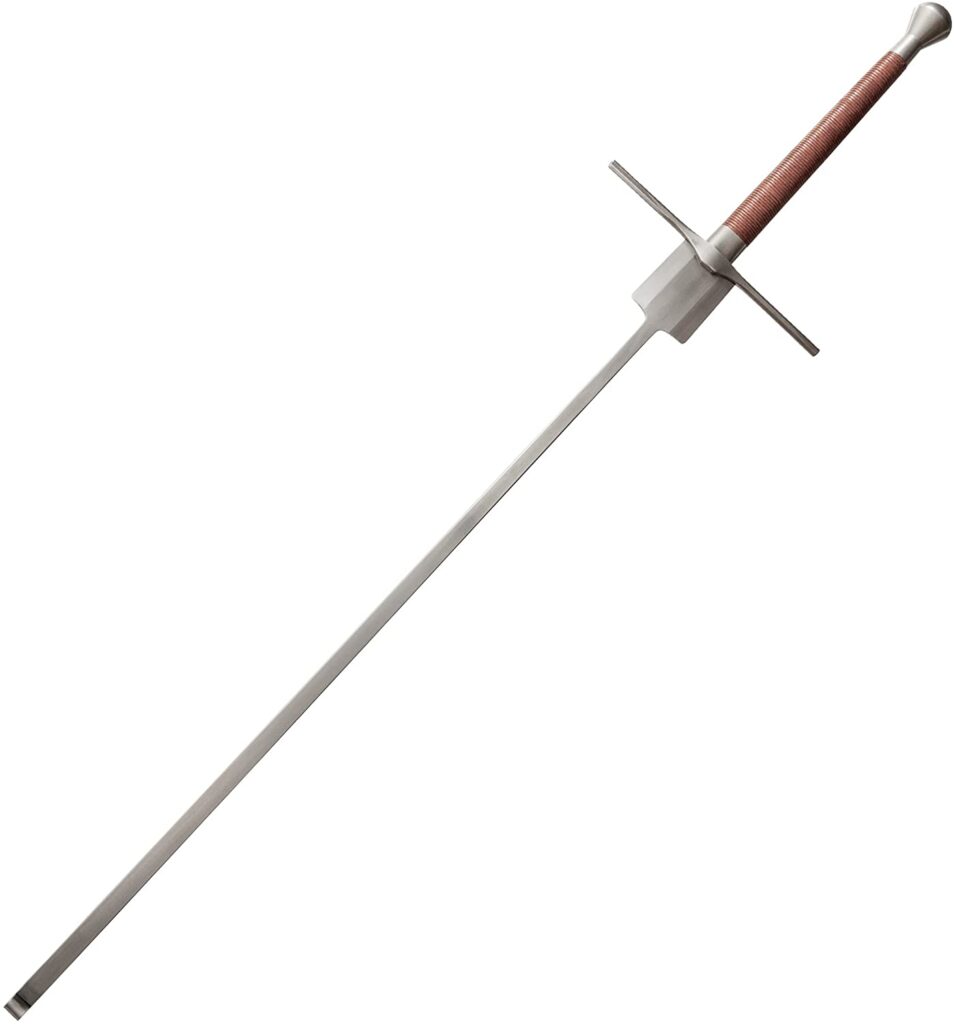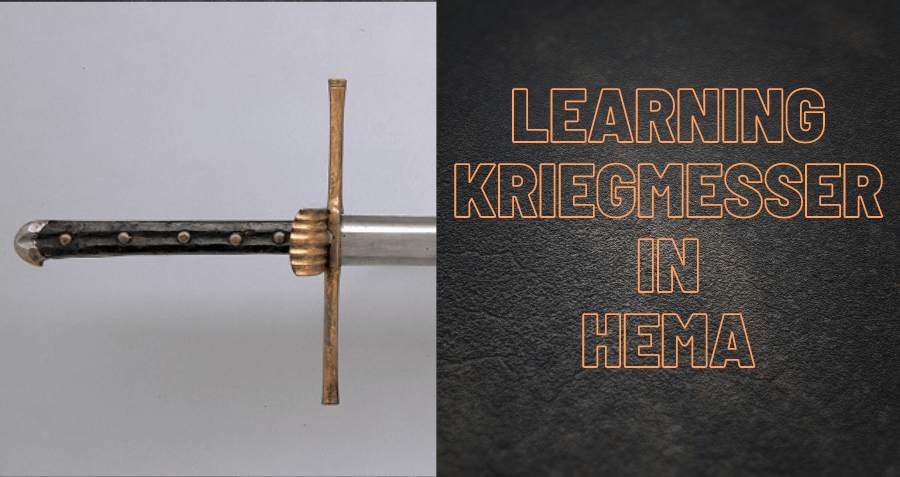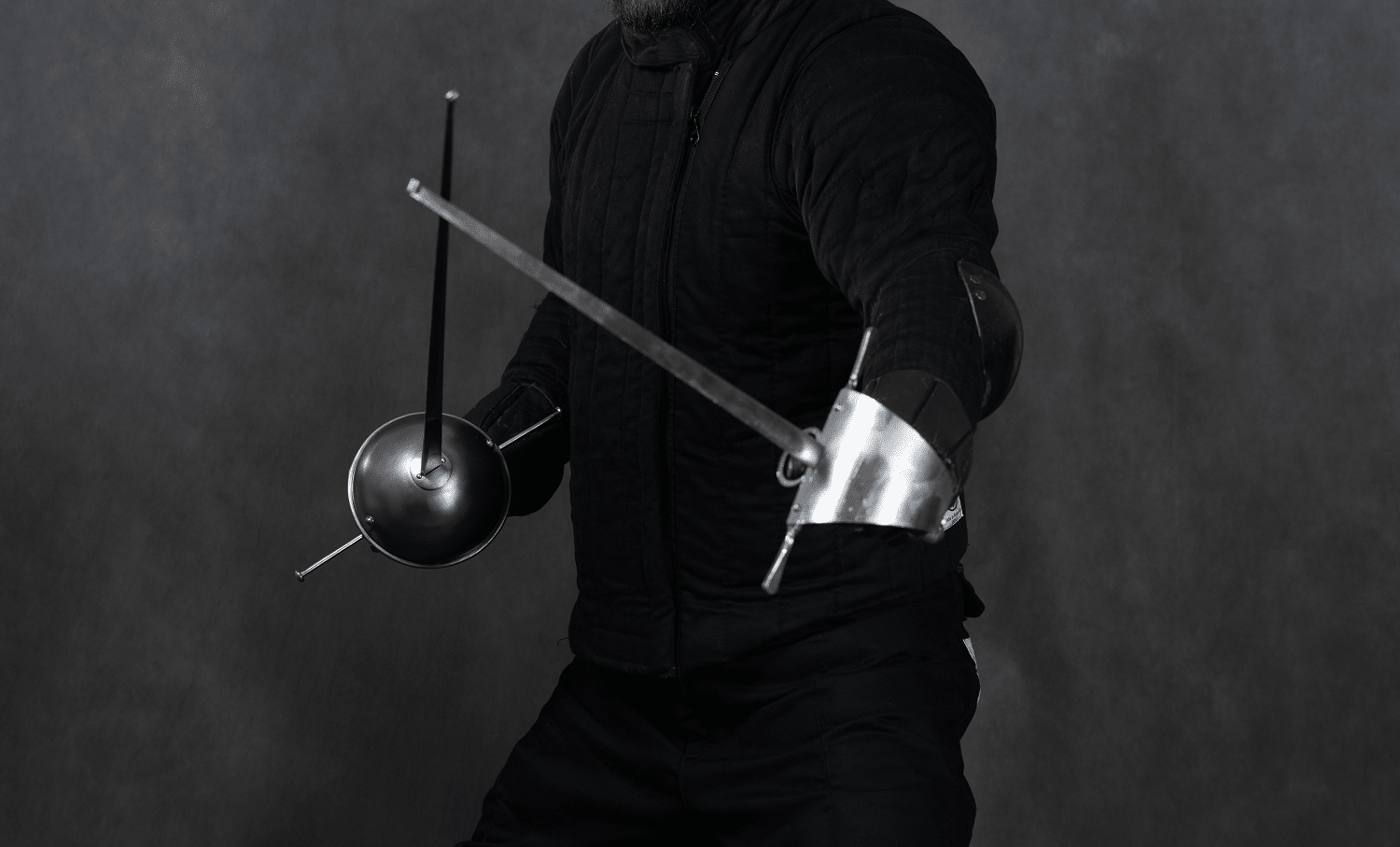This article is focused on discussing the CAS Hanwei Federschwert sword, which is also sold under the brand name of Kingston Arms Federschwert. Both swords are identical models distributed by CAS Hanwei, with Kingston Arms being an alias for Hanwei.
Please note this is a different model than the Sport Federschwert model, which is a newer model also produced by Cas Hanwei but has a very different style of blade. The Sport Federschwert is acceptable for beginners.
For a comparison between the newer Sport Feder model and the original model (which we don’t recommend purchasing) you can see the following video produced by the owner of Federschwert.com, which this website is an affiliate of. While Federschwert.com sells many Hanwei / Kingston Arms products and we promote some of them on this website, it’s important for people to understand these are primarily entry level tools for HEMA usage and to use them with appropriate care and consideration. This is important for safety.
This article also discusses the Hanwei Tinker Pearce Longsword line, which is arguably the cheapest sword on the market advertised for historical European swordsmanship test cutting. It is a very popular sword for test cutting in HEMA but there are special concerns regarding it which people should be aware of.
Mainly this article explains why you should be avoiding purchasing the original feder model from Hanwei for use in Historical European Martial arts (HEMA) / Western Martial Arts training. If you purchase a Hanwei feder model, it should be the newer generation Sport Feder one.
(As a note this article has been revised on 5/29/2021 to be updated to consider the latest manufacturing quality for Hanwei products).
Why You May Want to Avoid Purchasing Hanwei and Kingston Arms Produced Swords for Historical European Martial Arts Training
Hanwei is at present one of the largest and most successful distributors of swords in the world. The company’s full official name is Dalian Hanwei Metal Co. Ltd. and it was founded in 1990 by Chen Chao-Po, who also goes by the name Paul Chen when conducting business in Western countries. Previously Paul Chen had founded Taiwan Chengfeng Trading Co., Ltd., which specialized in selling custom made swords replicas for museum displays.
Early in its company life Hanwei gained a reputation for producing entry level katana swords for tameshigiri as well as unsharpened drawing swords for Iado that were more affordable than those produced in Japan at the time, and Hanwei also found success in producing replicas of well known museum pieces to sell to companies that operated mail order magazines for knife and sword enthusiasts. Many of their models were several hundred US dollars cheaper than those produced by other manufacturers, and this allowed Hanwei to gain a great deal of business.
As the Historical European Martial Arts movement became more organized and popular it found roots on online discussion boards that predominantly were used by sword enthusiasts, such as Sword Forum International. While the bulk of conversation on these forums revolved around historical swords and reviews of replicas produced by companies such as Hanwei, there also emerged a community of independent swordsmiths who were sharing information about sword smithing techniques and producing custom work for other sword enthusiasts. Most of this business was conducted on these internet forums, and some of the most popular smiths of their time were people such as Angus Trim, Daniel Watson and Michael Tinker Pearce.
Some time in the early 2000s the latter of these smiths, Pearce, leveraged his popularity and cooperated with Hanwei to produce a signature line of European longswords designed to be affordable for entry level test cutting, which is the Hanwei Tinker Pearce Longsword line that is still widely purchased. In the early days of HEMA, unsharpened blades with capped or cut points were also used by some HEMA swordfighters for steel on steel sparring. This usage of the Tinker Pearce longswords as steel sparring swords was before the widespread available of modern produced federschwert swords, which are the most common type of training sword used for HEMA longsword today. As such the Hanwei Tinker Pearce longsword has a place in the modern history of the HEMA movement and some veterans of the community are still sentimental about it.
However, Hanwei has in recent years had some mixed reviews of their products, as the vendors which they hire to manufacture these swords have been known to sometimes cut corners on the quality control, which leads to some blades that are unsuitable for use in HEMA practices. The primary problem with Hanwei produced swords is that the quality of the heat treatment can sometimes be inferior and inconsistent, leading to blades that are fragile and will easily break. This is not readily noticeable in the Tinker Pearce line of longswords but is obvious in the CAS Hanwei Federschwert sword, which flops around like a wet noodle and is notorious for shattering during blade to blade contact.
For a humorous video review of the original generation of CAS Hanwei Federschwert sword, you can watch this April Fools Day Review of the model produced by Blood & Iron. While the video is humorous, it clearly demonstrates the reasons why the CAS Hanwei Federschwert sword is not safe for practice.
As mentioned earlier in this article, Kingston Arms is an alias for Hanwei and this model of sword is often sold under this brand label. It is easiest to assume any Kingston Arms produced sword is the identical model as a Hanwei sword, because it is.
It is important to understand the problem is not that the swords are Chinese in origin. In actuality some of the most affordable and best swords produced in the world are manufactured in the city of Longquan. Presently, the majority of swords in the world are produced in Longquan, the other major hubs of modern sword production being in Solingen, Germany and Toledo, Spain. The vast majority of all cutlery in the world is produced in these three cities, and swords are classified as a form of cutlery. Granted, the overwhelming majority of swords produced in these cities are decorative wall hangers not produced for the rigors of blade to blade contact and will easily break but nevertheless these are the main cities where swords of all quality levels are manufactured today.
Let’s talk briefly about how swords are manufactured in Longquan, as this is where Hanwei sources its sword products. Hanwei, like most Chinese distributors of swords, does not actually manufacture its own swords. Rather their plants are locations were parts of swords (such as blades, crossguards, handles and scabbards) manufactured by others are assembled by low skilled laborers into a complete sword and then shipped to warehouses to other distributors and wholesalers in those countries. This is one of the reasons why most handles used in Chinese produced swords are cheaply glued to the wood from one strip of leather or fabric, and threaded screw-on pommels are more common than peened pommels; it makes it easier to assemble the swords. There are companies in Longquan that specialize in manufacturing sword blades, sword handles, guards and even scabbards. Orders are placed with each of these companies to manufacture parts to specifications and then the parts are ordered in bulk, then shipped to a central warehouse that is used as a plant for unskilled laborers to assemble the sword parts into a complete weapon, assembly line style.
On the subject of blades in particular, this process can impact the quality of the finished sword that is shipped to you. Blades for Hanwei swords are not always produced by the same forge; Hanwei contracts batches of swords to different forges based on their availability and prices. The varying price of steel at the time the orders are placed can cut into margins, and sometimes forges use lower quality steels than they claim to, often which have not had good heat treatment performed on them. This matters because most sword manufacturing in Longquan is performed using a stock removal process, where pre-heat treated steel is cut and shaped on a grinder into its final form. There are of course forges that do machine based hammering of steel stock rods into blades, and these are typically made from 1045 steel, which is suitable for making swords but requires proper heat treatment, which often does not happen. This is probably because European style blades do not have a hamon, and this is relevant because the vast majority of sword manufacturing in Longquan is focused on the manufacturing of Japanese style katanas. Heat treatment is not done at the forges that manufacture the blades and instead is predominantly performed at facilities that specialize in putting decorative hamons on blades. So if the manufacturer does not have an order for a hamon from the distributor who placed the order, they may not heat treat the blades at all, or if the treatment is done it is done as cheaply as possible on the belief “nobody will notice” since there is no visible hamon to easily identify a poor heat treatment. As the vast majority of people purchasing European style swords from Longquan only intend to hang these swords on their walls as decorations, the idea that people like us in the HEMA community will intend to use these for full contact sparring or test cutting practices isn’t something that many of the people involved in the manufacturing process think about. Sure, Hanwei may know what we intend to use these for, but the actual individuals producing these blades in bulk may not (or even care).
One thing to consider is that Hanwei claims that its line of Tinker Pearce longswords use 5160 High Carbon Spring Steel for the blades. This is a Chromium alloy, making it have similar rust resistance property as stainless steel. While 5160 is nowhere near as brittle as stainless steel and can be used to make excellent swords it still requires an excellent heat treatment to make a durable sword. With large orders of blades this is easiest to do with a computerized system to conduct the heat treatment but if anything goes awry then the entire batch is compromised as there is little margin for error in the heat treatment process for this type of steel when used as a sword.
This means that you often get very different quality sword blades that arrive at the Hanwei plant, and if Hanwei employees do not inspect every blade before assembly for quality control then you end up with a high number of defective blades shipped to customers. This is what we assume is happening at the Hanwei plants currently with their line of blades, including the Tinker Pearce line.
This is in contrast to a manufacturer such as Ronin Katana, which is also based in Longquan and uses many of the same forges that Hanwei uses to fulfill its blade orders. The difference is that Ronin Katana does scrutinize the blades that come in and rejects them for assembly if they are subpar; in this series of blog posts (Part 1, Part 2 , and Part 3) Ronin Katana founder Christopher Scoggin says he orders three times as many blades as he needs to sell, as he knows only a third of what he is sent will be acceptable. The unacceptable blades he then sells to other sword distributors, who assemble wall hangers with them.
Ronin Katana also requires blades to be produced with 1075 spring steel and its pommels to be peened. 1075 matters for large bulk orders of blades because it is easier to heat treat than the 5160 used in the Hanwei Tinker Pearce line. 1075 steel as a ‘plain carbon steel’ has a larger margin for errors during the heat treatment process when compared to a Chromium alloy like 5160. For this reason Ronin Katana has an excellent reputation as an entry level martial art sword distributor and it is why we recommend purchasing their swords for test cutting; you are significantly more likely to get a quality sword from Ronin Katana than from Hanwei because their production process is better for the intended purpose of these blades (test cutting).
It is worth mentioning that Cold Steel, an American distributor of edged weapons including swords, has a line of longswords popular with some in the HEMA community as well. Cold Steel primarily orders its blades from Taiwan forges, but the general idea still applies; parts are ordered and then assembled by low skill laborers in an assembly line.
We should also note most of these criticisms are not specific to the Hanwei Practical Rapier model, which we have recommend in our Rapier Starter Gear guide.
Oddly, these swords do tend to have suitable quality control in their production although their balance is not the best. In contrast to the original Hanwei feder model however they are not likely to shatter during light to medium free sparring. It is worth mentioning we also recommend in the same article the Fabri Armorum training rapier. Both models sell for roughly the same price, although if we had to pick between the two, we’d go with the Fabri. However Fabri is a much smaller company and sometimes their products are out of stock, whereas Hanwei almost never has any of their products out of stock so replacement blades are easier to obtain. Rapier wise, what we don’t recommend (yet is popularly recommended by others) is the Vicktor Berbekucz produced rapiers. These are sold in the US by Purpleheart Armory, but are far too heavy for most people. They seem to have been designed for SCA style cut and thrust fencing, which is not a strictly historical based fencing style. While the VB rapiers are sturdy and durable, their poor weight balance makes them unsuitable for beginners. There is, however, very few other rapiers available for HEMA in the price point compared to the Hanwei practical rapier besides the VB model.
Should You Buy a Hanwei Produced Feder At All?
Regardless of the reputation, Hanwei does offer a one year warranty against defects and breakage for their products so their swords are still popularly used within the HEMA community for test cutting. There are people who end up purchasing a solidly constructed blade that endures years of usage so depending on the price of the sword you find online, you may wish to consider rolling the dice and seeing if you get a good blade. If you don’t and it has breakage early on, it should be covered by Hanwei’s warranty for a refund or replacement.
As mentioned at the start of this article, we are discussing the original Hanwei Federschwert model of training sword, not the newer Sport Federschwert model. It is suitable for light to medium freeplay and drilling and it is recommended now on our longsword starter gear page.
Due to their price tag, some people may still find it useful to purchase a Hanwei sword for HEMA usage, so long as they use it with proper care and understand that very intense levels of force should not be used with them so as to be on the safe side.
We hope this article has assisted those new to the HEMA community in not only understanding how sword manufacturing is primarily done in China but also helped others avoid purchasing a badly manufactured sword from Hanwei / Kingston Arms. While they once had a good reputation in the HEMA community, it is our opinion that they have recently allowed quality control standards to greatly drop and using their weapons for HEMA practices should be done with some caution and attention to the quality of the blade you receive.
****
If you’d like to learn more information about historical fencing practices please check out our Learn HEMA page for a guide to learning about the historical weapon that interests you. You can also find more guides we’ve written about other topics at our Helpful Guides page. You can also join the conversation at our forums or our Facebook Group community.


















3 Responses
While they once had a good reputation in the HEMA community, it is our opinion that they have allowed quality control standards to greatly drop and using their weapons for HEMA practices is very dangerous.
This is all you really need from this article. If you wanna know why? Click this link. Saves a lot of time.
I own two hanwei tinker longswords (one customized, both sharp) and they’ve held up to stress tests pretty damn well. Whoever wrote this article clearly has something against Hanwei, Tinker and Kingston Arms. Also, it’s pretty clear that they’re fond of Michael Edelson, and while the RK euro line of swords is good, they’re on the same level as the hanwei tinker line. Don’t be fooled by the writer.